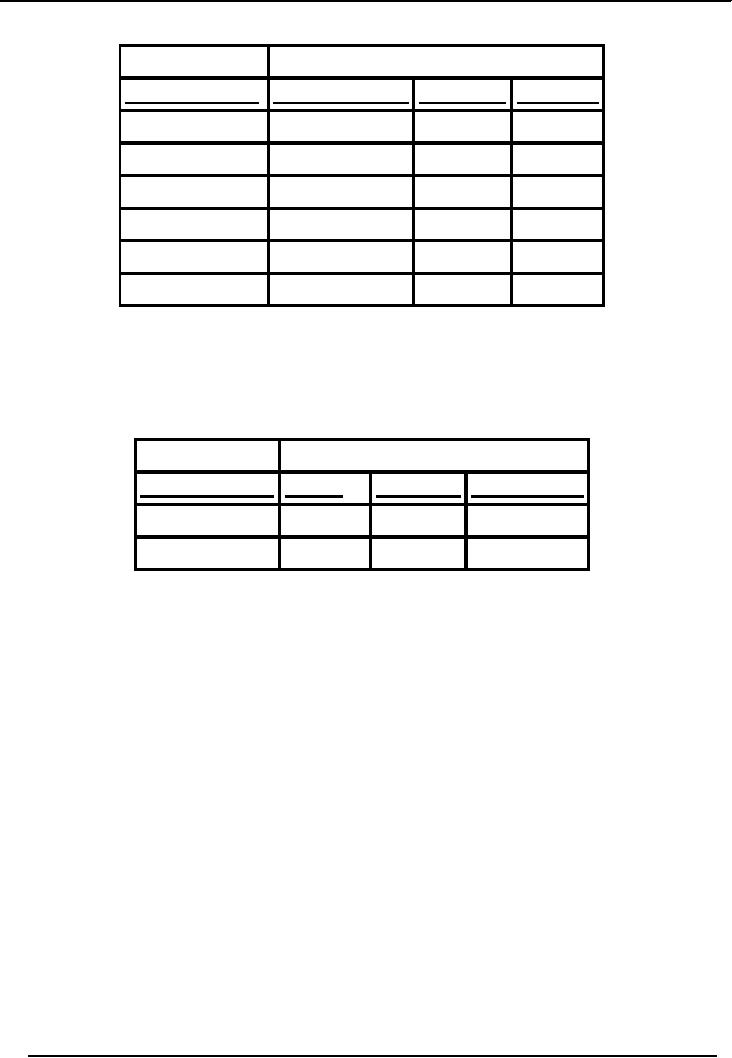 |
Charging Costs of Inventory to Income Statement |
| << Notes to Financial Statements |
| First-in-First - out (FIFO), Last-in-First-Out (LIFO) >> |

Financial
Statement Analysis-FIN621
VU
Lesson-19
NOTES
TO FINANCIAL STATEMENTS
(Continued)
Charging
Costs of Inventory to Income
Statement
This
is also known as cost flows
of inventory. Inventory units
may be acquired at
different
costs because of different
purchase dates or different suppliers.
Question is: Which of
these
costs
are to be used as "cost of
goods sold"?
Purchase/
→
Balance
sheet → sale
of goods → cost
of →
Income
Manufacture
current assets.
Good
Statement
Cost
of inventory
sold
(?)
Measuring
"cost of goods sold"
involves valuation and pricing of
Inventory and this is
determined
by Inventory Accounting
Policies.
As on
example consider that 2 ACs were
purchased in January @ Rs.20, 000
each, and 3
@
Rs.25, 000 each in February.
One AC was sold in March.
What would be the cost of
goods sold:
Rs.20,
000 or Rs.25, 000?
Two
approaches can be adopted in this
case i.e. specific
identification and cost-flow
assumptions.
Either is acceptable but an approach
once selected, is to be applied
consistently.
In
specific identification approach, the
Units are identified
specifically, which
clearly
shows
as to which particular unit is
being sold and what was
its cost, which would be
its "cost of goods
sold".
A Note
on the Impact of Inventory
Levels on Net
Income
Fluctuations
in inventory levels can
cause profit variations when
inventory is valued according
to
GAAP
standards. GAAP standards
require that all
manufacturing costs must be
capitalized in inventory
regardless
of whether the costs are
variable or fixed.
The
inclusion of fixed costs in
the unit cost causes
profits to rise as inventory levels
raise because the
fixed
cost in inventory is stored on the
balance sheet instead of being
carried over to the
income
statement.
When the inventory level
falls, this fixed cost
that has been stored on the
balance sheet is
moved
over to the income statement thereby
causing net profit to
fall.
To
illustrate this phenomenon I first
present a one month income
statement constructed using
only
variable
costs in inventory (in this
case, materials only).
Sales
$1,837,380
Cost
of materials
458,000
Margin
1,379,380
Expenses
Labor
224,000
Overhead
344,288
Depreciation
270,000
69

Financial
Statement Analysis-FIN621
VU
Administrative
210,000
Marketing
175,000
Total
expenses
1,223,288
Profit
before taxes
156,092
Income
taxes @ 35%
54,632
Net
Profit
$101,460
Computation
of Unit Values
Sales
Flow
Valves
Pumps
Controllers
Total
Units
7,500
12,500
4,000
24,000
Selling
Price $57.78
$81.26
$97.07
$1,837,380
20.00
22.00
458,000
Material
cost 16.00
Unit
margin 41.78
61.26
75.07
Total
margin
$313,350
$765,750
$300,280
$1,379,380
Next
I show two income statements for
two months with the
identical sales as in the first
income
statement
that uses only variable
costs in inventory. However, in
these two income statements
the
inventory
levels change; in the Month 1
statement the inventory of Valves
rises by 1,000 units, and
in
the
Month 2 statement Valve
inventory falls by 1,000
units.
Month
1
Flow
Valves
Pumps
Controllers
Total
Unit
Sales
7,500
12,500
4,000
24,000
Units
Produced
8,500
12,500
4,000
25,000
Ending
Inv.
1,000
0
0
1,000
Unit
cost
37.75
48.87
100.57
Sales
Price
$57.78
$81.26
$97.07
Dollar
sales
433,350
1,015,750
388,280
1,837,380
Income
Statement
Sales
$1,837,380
Cost
of goods sold
Begin
inv.
0
Costs
added
Materials
474,000
Labor
155,600
Overhead
682,688
Total
costs added
1,312,288
Goods
available
1,312,288
Ending
inv.
1,000
37,749
Cost
of goods sold
1,274,539
Gross
Profit
562,841
70

Financial
Statement Analysis-FIN621
VU
Administrative
210,000
Marketing
175,000
Total
expenses
385,000
Profit
before taxes
177,841
Income
taxes @ 35%
62,244
Net
Profit
$115,597
Month
2
Flow
Valves
Pumps
Controllers
Total
Unit
Sales
7,500
12,500
4,000
24,000
Units
Produced
6,500
12,500
4,000
23,000
Unit
cost
37.75
48.87
100.57
Sales
Price
$57.78
$81.26
$97.07
Dollar
sales
433,350
1,015,750
388,280
1,837,380
Income
Statement
Sales
$1,837,380
Cost
of goods sold
Begin
inv.
37,749
Costs
added
Materials
442,000
Labor
155,600
Overhead
682,688
Total
costs added
1,280,288
Goods
available
1,318,037
Ending
inv.
0
0
Cost
of goods sold
1,318,037
Gross
Profit
519,343
Administrative
210,000
Marketing
175,000
Total
expenses
385,000
Profit
before taxes
134,343
Income
taxes @ 35%
47,020
Net
Profit
$87,323
71

Financial
Statement Analysis-FIN621
VU
Notice
how the net incomes changed
from one month to the next even
though sales remained the
same.
This
example used activity based
costs for costing the
units of product, but any
costing method that
assigns
fixed costs to units will
give the same result.
To more
clearly show why the incomes
differ, consider the following table
that shows variable
unit
costs
and the unit fixed costs
assigned to the units by the ABC
costing system.
Flow
Valves
Pumps
Controllers
ABC
unit cost
$37.75
$48.87
$100.57
20.00
22.00
Unit
variable cost
16.00
Fixed
cost per unit
21.75
28.87
78.57
Times
x
Inventory
change in units
1,000
Equals--Difference
in pre$21,749
tax
income
Profit
before
taxes--unit$156,092
variable
costs
Profit
before
taxes--ABC177,841
unit
costs Month 1
Difference
in profit
before(21,749)
taxes
Profit
before
taxes--unit$156,092
variable
costs
Profit
before
taxes--ABC134,343
unit
costs Month 2
Difference
in profit
before$21,749
taxes
The
difference between the net income before
taxes for the income
statement with variable
costs and the
one
with the ABC costs is always
explained by the unit change in
inventory multiplied by the
fixed
overhead per
unit.
Inventory
Errors and Financial
Statements
Income
statement effects.
An
incorrect inventory balance
causes an error in the
calculation of cost of goods
sold and,
therefore,
an error in the calculation of
gross profit and net
income. Left unchanged, the
error has
the
opposite effect on cost of
goods sold, gross profit,
and net income in the
following accounting
period
because the first accounting
period's ending inventory is
the second period's
beginning
inventory.
The total cost of goods
sold, gross profit, and
net income for the
two periods will be
correct,
but the allocation of these
amounts between periods will be
incorrect. Since
financial
statement
users depend upon accurate statements,
care must be taken to ensure that
the inventory
balance
at the end of each
accounting period is correct.
The chart below identifies
the effect that
an
incorrect inventory balance
has on the income
statement
72

Financial
Statement Analysis-FIN621
VU
Impact
of Error on
Error
in Inventory Cost of Goods
Sold Gross Profit Net
Income
Ending
Inventory
Understated
Overstated
Understated
Understated
Overstated
Understated
Overstated
Overstated
Beginning
Inventory
Understated
Understated
Overstated
Overstated
Overstated
Overstated
Understated
Understated
Balance
sheet effects.
An
incorrect inventory balance
causes the reported value of
assets and owner's equity on
the
balance
sheet to be wrong. This
error does not affect
the balance sheet in the
following accounting
period,
assuming the company
accurately determines the
inventory balance for that
period.
Impact
of Error on
Error
in Inventory Assets =
Liabilities
+ Owner's Equity
Understated
Understated No
Effect
Understated
Overstated
Overstated
No
Effect
Overstated
Financial
Statements with
Inventory
The
statement of owner's equity
and the statement of cash
flows are the same for
merchandising
and
service companies. Except
for the inventory account,
the balance sheet is also
the same. But a
merchandising
company's income statement
includes categories that
service enterprises do not
use.
A
single-step income statement
for a merchandising company
lists net sales under
revenues and
the
cost of goods sold under
expenses.
73
Table of Contents:
- ACCOUNTING & ACCOUNTING PRINCIPLES
- Dual Aspect of Transactions
- Rules of Debit and Credit
- Steps in Accounting Cycle
- Preparing Balance Sheet from Trial Balance
- Business transactions
- Adjusting Entry to record Expenses on Fixed Assets
- Preparing Financial Statements
- Closing entries in Accounting Cycle
- Income Statement
- Balance Sheet
- Cash Flow Statement
- Preparing Cash Flows
- Additional Information (AI)
- Cash flow from Operating Activities
- Operating Activities’ portion of cash flow statement
- Cash flow from financing Activities
- Notes to Financial Statements
- Charging Costs of Inventory to Income Statement
- First-in-First - out (FIFO), Last-in-First-Out (LIFO)
- Depreciation Accounting Policies
- Accelerated-Depreciation method
- Auditor’s Report, Opinion, Certificate
- Management Discussion & Analyses (MD&A)
- TYPES OF BUSINESS ORGANIZATIONS
- Incorporation of business
- Authorized Share Capital, Issued Share Capital
- Book Values of equity, share
- SUMMARY
- SUMMARY
- Analysis of income statement and balance sheet:
- COMMON –SIZE AND INDEX ANALYSIS
- ANALYSIS BY RATIOS
- ACTIVITY RATIOS
- Liquidity of Receivables
- LEVERAGE, DEBT RATIOS
- PROFITABILITY RATIOS
- Analysis by Preferred Stockholders
- Efficiency of operating cycle, process
- STOCKHOLDERS’ EQUITY SECTION OF THE BALANCE SHEET 1
- STOCKHOLDERS’ EQUITY SECTION OF THE BALANCE SHEET 2
- BALANCE SHEET AND INCOME STATEMENT RATIOS
- Financial Consultation Case Study
- ANALYSIS OF BALANCE SHEET & INCOME STATEMENT
- SUMMARY OF FINDGINS